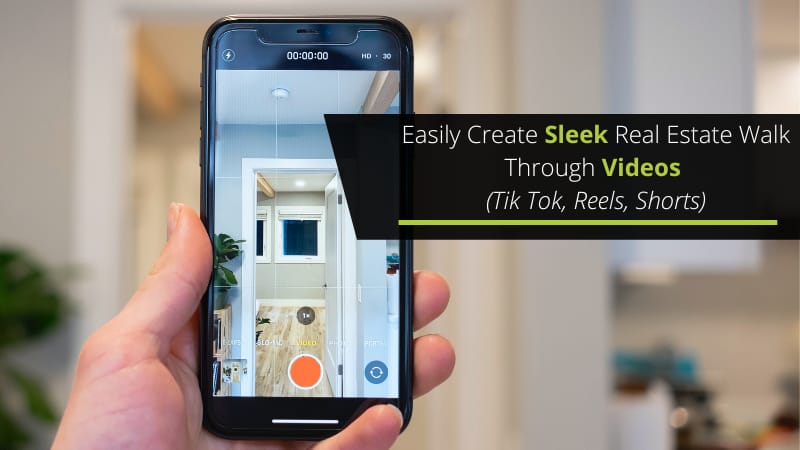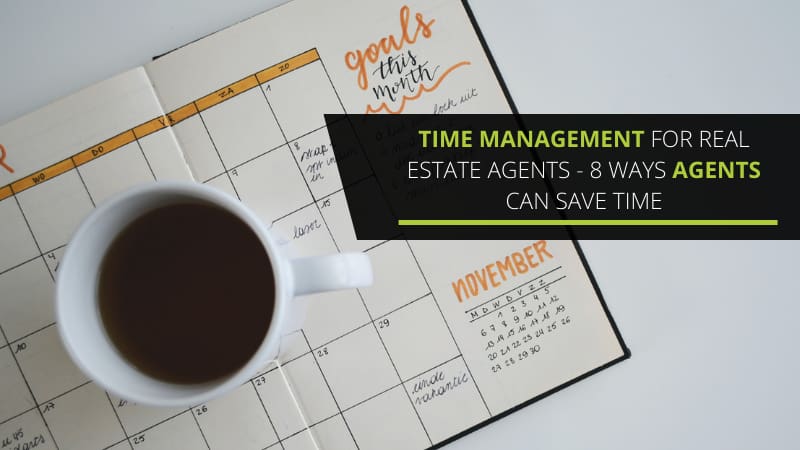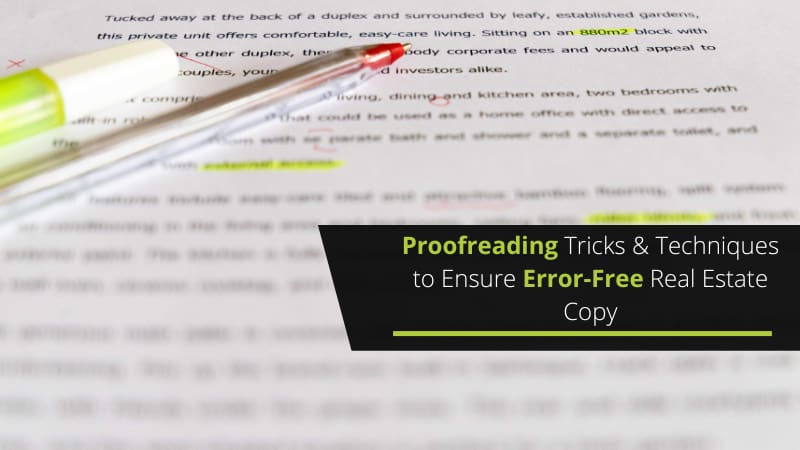Easily Create Sleek Real Estate Walk-Through Videos (Tik Tok, Reels, Shorts)
In 2021, TikTok helped Melbourne-based Collings Real Estate sell a property in just six days. We’ll look at the video, what they did, and the takeaways you can use in your own videos below.
If you’re wondering how TikTok and the short-form video trend could help sell real estate, consider that 43% of home buyers are millennials, and they watch a lot of online videos – up to 10-20 hours a week for some.
The pandemic saw real estate walk-through videos explode as people couldn’t go to in-home inspections. And this trend hasn’t slowed. With new apps and social media networks coming onto the market every day, like the new TenSixty app – basically TikTok exclusively for real estate – it pays to use video as part of your marketing mix.
Not every video has to be a high-end production. If you check out the 1060 app, you’ll see many of the videos are a basic walk-through done on a smartphone. Creating property videos yourself can add value for your clients without going to the expense of hiring videographers. Professional videos are great for luxury and high-end homes, but everyday homes can benefit from video, too, with the tips below.
If you’ve never shot a video, short-form video is an easy place to start because done and uploaded is better than perfect. But if you’re looking for ways to outshine the competition in the video space without spending a lot of money on videography, this comprehensive guide has you covered.
The Benefits of Short-Form Video
The great thing about short-form video is that it’s, well, short—just sixty seconds.
Short-form video:
- is quick and easy to produce – use your phone, no special equipment
- has a low barrier – anyone can do it and then repurpose it on multiple platforms
- is low cost/zero cost. It doesn’t have to be a high-end production (but it can be)
- it’s an excellent way to sell you, the realtor, along with the listing
- is fun and flexible, with less pressure to be ‘buttoned-up’.
It can be something as simple as a sneak-peak introduction to a new listing, a complete walk-through video of a home, or a first-class marketing promo.
Best Platforms for Sharing Your Videos
You can shoot short-form video once and share it on multiple platforms, including:
- TikTok
- Instagram Reels
- YouTube Shorts
- Facebook Reels
- TenSixty App
Which platform should you focus on?
The best platform is the one your potential clients are using. Instead of spreading yourself thin, focusing on just a couple of platforms is best. If you’re not sure which ones, experiment to find the best marketing channels for you.
Shooting a Pro Real Estate Walk-Through Using Your Phone
Before we get into how to shoot video, here’s what you need to consider before you start rolling the camera.
Consider Marketing Fundamentals
Short-form videos allow you to be fun and relaxed, but at the end of the day, you’re still trying to sell a house. So it’s essential to keep the basics of marketing in mind. These include:
- Who is your target audience?
- What are the best features and benefits of the home?
- What is the lifestyle picture you’re trying to paint?
- Given the property and the audience, what tone do you want to set? Fun? Sophisticated? Executive?
- What is your call to action going to be?
Equipment You Might Need (Besides Your Smartphone)
To take a basic video, all you really need is your smartphone.
However, for a more professional-looking real estate video, there are a few inexpensive pieces of equipment you can add to your kit. These include:
A Gimbal – this will help stabilise your phone, creating smooth shots. You can get a handheld smartphone gimbal for around $100.
Extra storage – video footage can take up a lot of storage space. An additional storage card for your phone with online backup ensures you won’t run out of room while shooting.
A microphone – if you plan to talk in your videos, a microphone is a must. You can use the microphone on your air pods or invest in a wireless Lavalier mic for around $40.
Wide Angle Lens – not essential, but a wide angle lens attachment for your phone is an inexpensive way to get those wide room shots and improve your video footage.
Video editing App – (see below) free or low cost, editing your video footage will give it a professional polish, elevating it above the competition.
Video Settings
Video settings are consistent across all the platforms, so it’s easy for you to shoot and share one video on multiple channels.
Before you start recording, check the following:
- You’re shooting vertical for short-form video, not in landscape
- The aspect ratio is set to 9:16
- The resolution is set to 1080×1920
- You save the file as an MP4 or MOV file.
Create a Shot List
Pro videographers will tell you a shot list is a must!
Whether you do this in your head or on a piece of paper, a shot list will ensure you capture all the video you need.
You will want to film each room from one or two angles, as well as the outside, garden, driveway, and any lifestyle or location shots you want to add, including drone shots, if using.
You will also want to plan how you shoot each location. Before you start videoing, walk through and consider the following:
- From what angle(s) should you shoot each room?
- Are there any features that should be highlighted, maybe by zooming in on them?
Don’t forget to highlight the home’s features that will stay with the house, like a fireplace or kitchen, rather than the decor.
Before You Shoot…
Before you take any videos, make sure to:
- Tidy up and stage the home
- Turn on lights and open blinds
- Close closet doors and loo seats
- Add lifestyle props you want to use
Film Quality Real Estate Walk-Through Videos With the Following Tips
Now that you’re ready to start shooting, here are some tips that will elevate the quality of your videos and make them stand out.
Move Smooth
Make your videos interesting with movement rather than static shots of a room. Have the motion be slow and smooth so viewers can take in the details. This is where a gimbal can help. You might consider walking towards or away from features or zooming in and out to create interest.
If you only have still photos, you can ‘cheat’ by adding movement in the editing app.
Consider the Walk through Flow
As you pan from one side of a room to another, consider the home’s natural flow.
For example, if an ensuite is to the right, pan the camera from left to right, ending at the ensuite with the next shot inside the ensuite, creating a logical flow to your video.
Take Many Short Videos and Stitch Them Together with Transitions
Consider transitions as you shoot.
A transition is when an effect, like a fade, is added between two shots. Video editing apps allow you to add these as you edit a video.
If you watch other walk-throughs, you’ll notice some editors use speed (a slow pan finished with a super quick transition) to stitch together shots.
You can film transitions, too, by ending a shot at a column or blank wall before starting in a different room.
Set the Scene, Tell a Story
Many Hollywood movies start with aerial shots of a city or area to quickly tell viewers where the film is set.
You can do this too with drone video, stills of the home if you have them, or even a shot of you walking or driving up the street and into the driveway.
It’s also helpful to add videos of location highlights like the local beach, shopping centre, or school. When taking footage of location highlights, make sure not to video people without their permission – early in the morning when no one is about is a good time.
Top tip: keep this footage and reuse it in other listings to save time in the future!
It’s also a good idea to tell a lifestyle story in your video with simple visuals.
For example, turn the fireplace on and place a throw rug, a magazine and a cup of coffee in the shot to paint the picture of how the space can be enjoyed. Or put a cheese platter and some glasses of wine on the table in the alfresco.
Support the Visuals with Music
Music can give your video another dimension of interest and reinforce the mood you’re trying to set.
For example, music for a family home with a pool might be fun and upbeat, while music suited to an elegant luxury property might be slow and sophisticated.
While many short-form videos use popular and trending music, it’s better to use music you have permission to use. Look for royalty-free music that can be used in commercial videos.
Video Editing Apps - Easily Get Your Video From Phone to Web
While you can shoot videos with the native video recorder inside TikTok or Instagram, your videos will turn out A LOT better if you take a little time editing them.
Many free and low-cost video editing apps are available to help you easily edit and polish your videos. Some of the more popular ones include:
- FilmoraGo
- InShot
- Vimeo Create
- Adobe Premiere Rush
- LumaFusion (iOS)
- iMovie (ios)
- KineMaster
The key feature is to be able to trim and stitch your clips to sixty seconds to end up with a more polished video. Instead of making the viewer wait while you walk from one room to the next, you can stitch a kitchen shot with a lounge shot, a bedroom shot etc., producing a tighter video.
Adding Microcopy/Text Overlays
Microcopy is small snippets of copy that aren’t essential but help the viewer get a better understanding of what they are watching.
While you don’t have to add text to your video, some well-timed microcopy can give viewers info they can’t get from images alone.
Here’s a great example of text used sparingly in the video to add an extra layer of information to the walk-through:
What we love about this video:
- Great use of drone and outdoor shots to set the scene
- Use of running water sound effects to highlight the fountain and shower
- Well-timed microcopy to give viewers extra information (in a font that suits the home)
- Evening shot with fires lit to add lifestyle benefits and a give a sense of story (ending at night)
- End card with a call to action letting buyers know the next step to take
Talking in Your Videos? Consider a Script
Talking in the video – describing the features and benefits – not only increases accessibility (great for those with vision impairment), but the video does double the work – promoting both the home and you as the agent.
If you talk, especially in short-form videos, then a script is a must – even if it’s just a few bullet points jotted down for you to refer to.
Below is a great example of a tight, well-scripted real estate video. Compare it to this one that goes for 15 minutes. That’s way too long, even for a YouTube video. Don’t lose your audience by waffling on.
What we love about this video:
- The script is tight, relevant, knowledgeable, and without waffle
- There’s plenty of movement while the agent talks to keep viewers interested
- The agent describes the layout and features succinctly and with enthusiasm
- The video supports what the agent says (there are shots of local amenities when she talks about location)
- There’s a call to action at the end of the video telling buyers what the next step is.
How to Make a Viral TikTok Real Estate Video
The Collings viral real estate video mentioned in the introduction of this article wasn’t shot on just a smartphone – it was a full-scale production.
But there are some important takeaways that you can implement in your own real estate videos. First, here’s the video in full:
In this video, they jumped on the trending hashtag at the time (#dreamschallenge) where people were sharing videos of themselves skating while drinking cranberry juice.
This cleverly defined the target market, showed the local surrounds, and painted a lifestyle picture. Adding the trending hashtag increased the video’s exposure.
The takeaway: what trending topics can you naturally incorporate into your videos to help them get exposure?
Here’s what we love about the video:
- Use of an actress to create a different and more interesting walk-through video
- Slow pan shots of every room
- Cuts between clips rather than a single long video
- Great use of text overlay as a DM to list the local attractions
- Text overlay naming the local surrounds they skate through
- The storyline starts with waking up and having breakfast, ending with watching the sunset
- Viral skateboarding shot to jump on the social trend.
- Story, lifestyle, and property walk-through all in a two-minute video.
You’re not going to be able to jump on a social trend for every video you produce, but if there is one relevant to the property you’re videoing, adding it can be a great way to increase exposure.
You can go overboard with this. For example, in this video, Collings Real Estate used a James Bond theme to show the house. Fun and viral, definitely. But perhaps too much? What do you think?
The pandemic made walk-through videos an essential part of the marketing mix. And with a tightening market, the most successful real estate agents are using marketing strategies that reach their potential buyer, many of whom are millennials or younger.
Creating a short-form video is much easier than a full-scale professional production, but it still takes time. We can take some of the load off by writing your listing copy, other marketing collateral, and even video scripts! Call or email us to find out how we can help you, or check out our ‘how it works’ webpage for more details.












